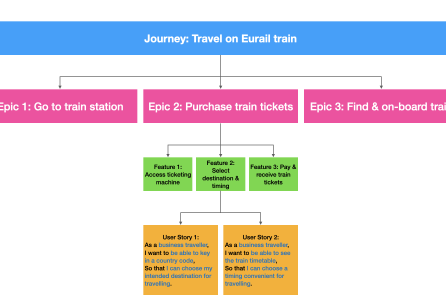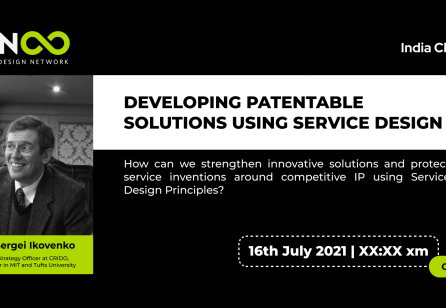What are Service Design's underlying principles?
I think it's about creating culture and largely that's not just talking and post-in note fantasia. It’s really about understanding the processes behind the things that you're designing for, how your designs are going to affect it, and how you can make it economically sustainable. If you consider service design’s evolution, it has always grown from creating a competitive advantage. A service culture helps or hurts everything you do and if your organization’s culture doesn’t support valuable services it won’t be sustainable or reliable over time. Orchestrating parts of a large system that no one group can control requires better habits, reactions, and empowerment. That all stems from culture. Service design is a team sport it takes a lot of people working together.
From a practical application perspective, prototyping and making as early as possible is a core principle. I try to get as wrong as possible so I can right faster. One of the best phrases I've ever learned in design was from Bruce Hannah at Pratt, "Mock It Up Before you Fock It Up". It's so important to talk just enough to get a few ideas then use prototyping as your research. In my practice, design and research are not separate. They're the same thing. I mean making to learn. I start with early designs as research and strategy prompts. Iterating and scrapping concepts all the time is a reality. Services are never done, so the idea of “final designs” doesn’t make sense to me. Service concepts might look good. They might not. It’s just a way to create something for people to react to. You're making it so everyone involved understands this is going somewhere. Essentially your initial designs are saying, "I've learned enough to be dangerous about the problem we are solving. Here's what I think could help, but ultimately, its a stab." You show the work to people and you hope that they tear it up, because that's the best thing that could happen to you.
You hope they tear it up? Why is that?
Because you can take a lot of time and think you're right and try to refine something until it gets right. If it turns out you’re totally wrong, you’ve wasted a lot of time and money. Whereas, designing to be wrong relieves the pressure to be “right” and reduces the risk your concept is a bad idea that will end up getting shelved. So, make it real for someone that's not involved. Let them tell you where you are wrong. In my experience, you're going to find out what you're not thinking about and get the answer to questions you wouldn't have known to ask. It has saved me time, money, and reduced the chances of falling in love with something that didn’t work. The biggest pitfall I have seen is when, once you make something digital... let's say you make it in Illustrator or Indesign... once it goes beyond a whiteboard sketch, it's really tempting for it to become precious. It is counter intuitive, but the best design decisions I have made came when I have totally “scrapped” a concept but keeping what we have learned.
No one group can be smart enough to get a service concept right, and create a perfect system without making a lot of mistakes really fast. If your mistakes are really slow it costs a lot more money to throw away a bad idea. Your project is going to be over budget. Your clients aren't going to be happy. Your teams aren't going to be happy because you just spent a lot of time and effort on something that wasn't even the right idea.
What would you consider to be some of the biggest wastes of time when it comes to this?
Probably the biggest waste of time starts with how service design is so sold, especially if you're a consultant. It's still largely sold the way advertising evolved. It's, “You're going to hire us. We're going to make this thing. We're going to have this end deliverable.” That's really not the best way to sell it because you put yourself in a position where you might sign up for something that you have to deliver that really is not beneficial to what's actually going to solve the problem you discover. That’s probably where people really set themselves up for pain. If you start a project with a result in mind or “deliverables” set in stone you are asking for trouble, but that is how marketing and advertising got started. It’s causing selling pains for organizations because it pitches really well. Clients become attached to concepts like case studies and mock-ups. Those are just propaganda that creates a false sense of certainty. Every service system in each company is so unique that what works at one place will not work at another for a few hundred reasons. It is not some great mystery why no NFL coach has ever won a Super Bowl with two different teams.
The way design is sold undermines its value. Lawyers don’t give free briefs. Accountants don’t give away audits. To do service design we need access to what is actually going on inside an organization to be effective. You can not talk about that kind of work in case studies. That’s such an old way. It’s tough for some organizations to share details. At SERV/ we don’t that. We view service design more like attorney’s than a traditional consultancy.
Who do you think is doing this in the most unorthodox way you can imagine and successful at it? And why?
I think what you see is service design going internal. Something that I would look at is University of Pittsburgh Medical Center. They're basically taking the business model of healthcare and health services and flipping it on its ear. They're changing the underlying base to cost structure of healthcare. I think Blue Cross Blue Shield, in Philadelphia, is doing some cool stuff from a cultural perspective. Capital One is evolving to make financial services easier to understand. I like that they're changing the business using a service design approach in large parts of their organization. They're changing the way healthcare and financial service are done.
Any last bit of words for people who are just stepping into this?
I am an accredited SDN Master trainer, so starting January 6th, 2018 I am offering a 12-week part time SD Certificate course live online and in person here in Chicago on Saturday mornings. If you are looking to get a running start into service design, my course will definitely give you enough to be dangerous.
It’s really important to embrace acquiring new skills. Services are always going to change and you have to be ready for it. Service designers have to genuinely want to learn from how people are living and understand what's valuable to their employees and consumers. If you can learn to love finding out what they don't know a lot of success will follow.
In closing, when you set out to understand people and improve the way a brand serves them, the organization generally saves money. There's always a relationship to be maintained. There's always a connection to have between your brand and the people you serve. It all has to work together. It is for these reasons that we are witnessing service design moving internal more than growing as a consultant.
Follow Rich:
Twitter @RichEkelman
Follow Serv/
www.servinnovation.com
Serv/ Blog
Twitter: @SERVppl
Instagram: @SERV724










Share your thoughts
0 RepliesPlease login to comment